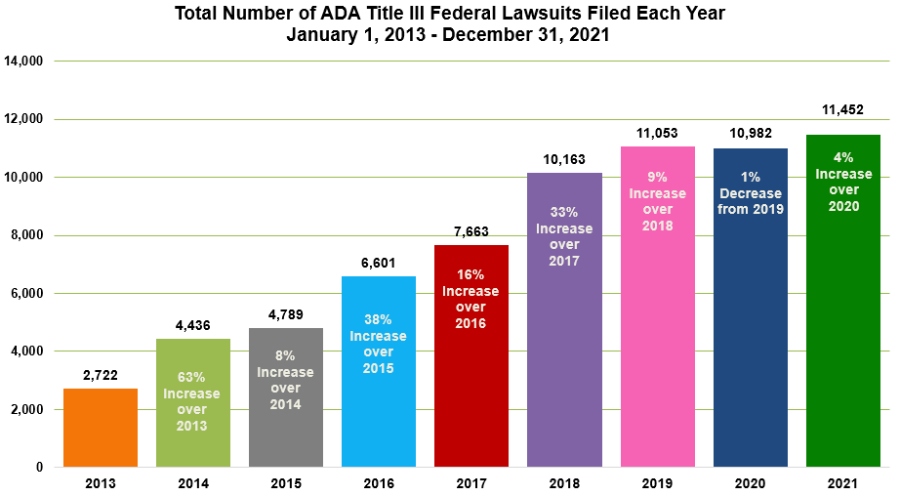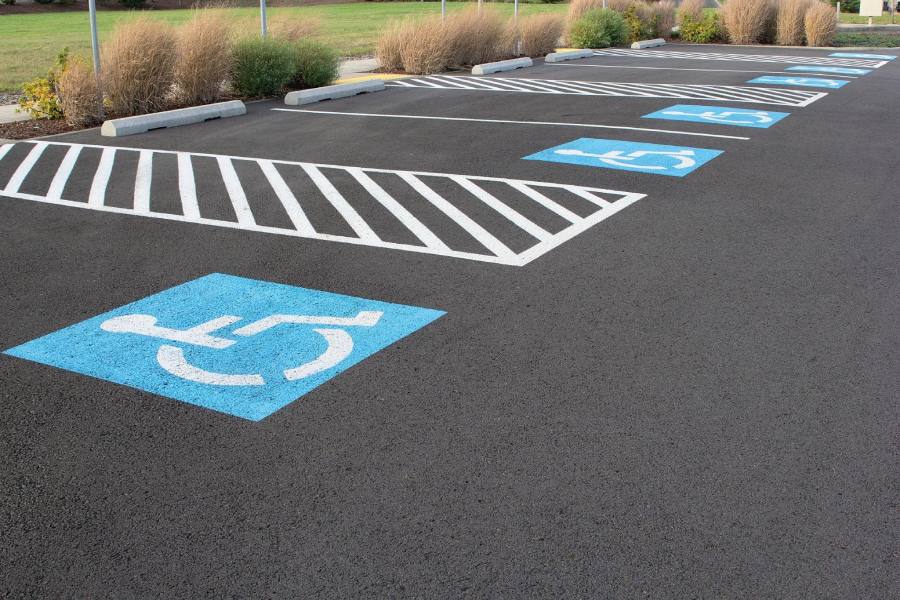With more than 50 million Americans with disabilities, ADA compliance is important not just from a legal perspective, but a human one.
How to Maintain ADA Compliance for Retail Stores
This article is part of a larger series on Retail Management.
Among the many legal and regulation considerations when starting a retail store is compliance with the Americans with Disabilities Act (ADA), which safeguards accessibility. For brick-and-mortar operations, this involves making achievable accommodations in your store’s exterior, interior, and employer requirements. Ecommerce businesses should also take care to stay ADA-compliant—in fact, ecommerce made up 79% of all digital ADA lawsuits in 2022.
Let’s take a look at what you need to do to maintain ADA compliance and an accessible retail store.
What Is ADA Compliance for Retail Stores?
The Americans with Disabilities Act (ADA) was signed into law in 1990 to ensure businesses and public facilities are accessible to people with a range of disabilities, be they physical or mental. ADA compliance in retail is the process of making sure your store meets the requirements set forth in the ADA’s parameters. This mainly relates to physical spaces and digital content.
ADA compliance fosters inclusivity, allowing everyone to shop comfortably and access information online without barriers. It not only complies with legal requirements but also creates a welcoming atmosphere, expanding customer reach and demonstrating a commitment to corporate social responsibility (CSR).
Why Is Accessibility Important?
According to estimates from the US government, there are more than 50 million Americans with disabilities—that’s a massive group of potential customers. At a bare minimum, ADA compliance widens your audience base to include this underserved and often disregarded segment.
Plus, not being ADA compliant can also mean you have to pay costly fines and lawsuits. The total number of federal lawsuits filed is on the rise, year after year—peaking at 11,452 in 2021 alone, a 4% increase from the year prior.

(Source: ADA Title III)
As far as municipalities go, less than a quarter are ADA-compliant. This means there’s a major opportunity for small business retailers to cater to a market that has been largely cast aside by businesses and governments alike.
Retail is also the top industry targeted by ADA lawsuits. While brick-and-mortar cases are decreasing overall, there were as many as 4,455 filings for ecommerce (websites and apps) in 2022.
Beyond legal requirements and ramifications, being ADA compliant can also improve brand image. Consumers are increasingly looking to support businesses with a strong commitment to CSR in their core values, and minding ADA compliance is one way to win these conscious consumers over.
How to Meet ADA Compliance Requirements
There are a few key areas to keep in mind when addressing ADA compliance in retail stores, from your physical space to your hiring policies.
Exterior of Your Store
First, you’ll want to make note of the exterior of your store. This includes paying attention to the parking area, sidewalks, entry/exit, and potential obstacles.
Parking

It is imperative that you have parking dedicated to those customers with disabilities.
Parking is a pretty big concern when it comes to ADA. If you have a parking lot, you’ll need to make sure you have spaces dedicated to shoppers with disabilities. These spaces must be adequately marked and provide at least three feet of clear area on either side of the space. Make sure parking signage is still visible even if cars are parked in the spaces.
Additionally, it’s important to remove any obstacles from your curbs, signs, access aisle, curb ramp, and route connecting the ADA-compliant space to your store entrance—the route should be at least three feet wide. The parking area itself should be free of cracks, potholes, raised areas, shopping carts, gravel, snow, ice, mud, debris, trash, maintenance equipment, leaf piles, and product displays.
Entry & Exit
The ADA pays special attention to entrances and exits, as it’s important they’re easily accessible to all individuals. The doorway must be at least three feet wide, as well as the route leading up to it. Keep in mind, the route must be smooth and free of any major issues like cracks, unlevel surfaces, or potholes.
You’ll also need to make sure the route and entryway are unobstructed—anything hanging above, such as trees, business signs, stringed lights, hanging plants, etc. must be at least 80 inches above the walkway. Anything beside the route shouldn’t extend more than four inches into the route.
When it comes to the actual doorspace of your entryway, make sure there’s nothing between 18 and 42 inches on the latch side of the door which could prevent it from opening all the way. Remember, the entryway must be at least three feet wide.
Your main entryway may not have the space to become ADA-compliant. In this case, you can create an alternate accessible entryway. It’s important that all accessible entrances and exits remain unlocked during your store operating hours. Additionally, alternative entrances must be adequately marked with directional signage.
If you have an elevator, maintenance and functionality are of utmost importance. Like your entrance and exit, elevators should be free of obstacles such as trash or product displays.
Interior of Your Store
ADA compliance should be top of mind when planning your store layout. Keep the following retail store ADA compliance information in mind when it comes to the inside of your shop.
Store Layout
When designing the inside of your retail store, there are many ADA requirements to consider. In sum:
- Product displays, seasonal installations, visual merchandising, and all other physical objects must remain clear of all paths—nothing can protrude into the path more than four inches.
- Keep all paths free of long fabrics, like tablecloths or curtains, that may get in the way.
- Make sure there’s clear directional signage leading from the accessible entry to other areas of the store.
- Avoid low-hanging lighting fixtures, signs, shelves, etc. that may obscure physical pathways or vision—try to keep things at least 80 inches above the walkway.
If you’re undergoing any repairs or upgrades to the space that require customers to detour, those detoured routes must also be accessible and well-marked.
Checkout & Counters

As far as your checkout and other service counters are concerned, the biggest restrictions pertain to height and the surrounding area. Counters should be at least 36 inches wide and no more than 36 inches tall. The checkout area should have a clear space of at least 30 inches by 40 inches big. Additionally, your accessible checkout area must be staffed at all times during business hours.
Restrooms
If you have customer-friendly restrooms in your store, they also need to be accessible per ADA. Entrances must be obstacle-free, and there should be nothing prohibiting the door from opening all the way. Restrooms should remain unlocked during business hours or the keys should be available in an accessible location if you need to keep them locked. Make sure signage is easy to see and follow—the main sign should be mounted next to the latch side of the door, 5 feet to the center of the sign.
Once inside the restroom, ensure there’s nothing in the way. This includes trash cans, chairs, shelving, and bathroom supplies. You also need at least one sink no more than 34 inches from the floor—with a minimum of 48 inches of clear floor space underneath—as well as an accessible toilet no more than 19 inches tall, with grab bars.
As far as maintenance goes, it’s a good practice to keep your restrooms clean and stocked—but it’s also required. Any accessible soap and paper towel dispensers should always be filled.
Fitting Rooms
Fitting rooms have similar requirements to the restrooms. They should be free of obstacles. If you have several fitting rooms, you could make one accessible and keep the rest furnished with extras. Proper signage is also required.
Printed Information
When it comes to printed information, be it catalogs, in-store signs, flyers, or anything else, there are some extra considerations. First, the colors should have enough contrast so it’s easy to read. Additionally, printed material must also be available in Braille. You might also have large print versions. If you have digital displays, consider offering an audio version, as well as subtitles if someone’s speaking.
Digital Accessibility
Whether on your website, online store, apps, or digital files, there are a few steps you should take to maintain accessibility. Here is a checklist for conducting a manual digital accessibility audit:
- Take stock of all your digital assets, including multimedia (PDFs, audio and video files, etc.), and run a scan using an automated accessibility tool.
- Have a website accessibility statement or policy page. Also provide contact information for when users want to request accessibility information.
- Follow website design and accessibility best practices, including:
- “Skip navigation” links on webpages
- Proper heading tags in a hierarchical structure
- Alt text for images and other non-text content
- Descriptive and relevant anchor text for links
- Optimized checkout experience
- Consider practice testing with community users, such as those using screen readers.
Employer Requirements
If you’re an employer, all the same requirements for your customers apply to your workers, with some additions. First, you must abide by the U.S. Equal Employment Opportunity Commission (EEOC). Essentially, you can’t discriminate against anyone in the hiring process if they have any disabilities. The requirements are a bit more flexible if you have fewer than 15 employees, but it’s still important to keep in mind.
Additionally, properly train and inform your staff about the accessible modifications and resources in your store. The more they know, the more they can help you maintain an inclusive shopping environment.
Frequently Asked Questions (FAQs)
Here are a few of the most common questions and concerns retailers have about staying ADA-compliant.
ADA in retail is the Americans with Disabilities Act, which was passed in 1990 to require businesses and public spaces to maintain accessibility for people with all sorts of physical and mental disabilities. It’s important for retailers to understand and adhere to the guidelines outlined in the ADA.
The ADA height for retail counters is 36 inches.
- Create accessible entryways and exits
- Maintain proper signage
- Offer accessible parking areas
- Ensure fitting rooms and restrooms are compliant
- Have clear pathways with signage
- Ensure digital accessibility
- Maintain inclusive hiring and employment policies
- No more than 36 inches tall
- At least 36 inches wide
- Staffed at all times during operating hours
- Clear space of at least 30 inches x 40 inches
Bottom Line
ADA compliance is important not just from a legal perspective but also a human one. Consumers come in all shapes, sizes, and forms, and it’s important for businesses to accommodate the unique needs of differently abled persons. Maintaining accessibility is one way to show your brand cares about people, which can boost brand image, customer loyalty, and, ultimately, sales.